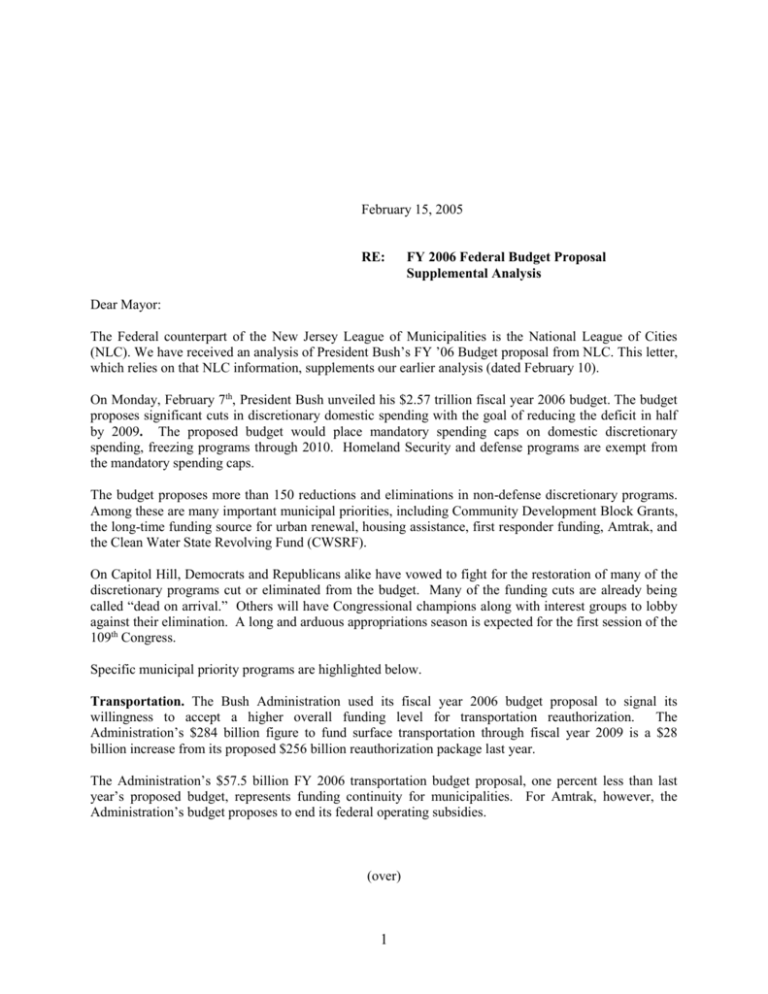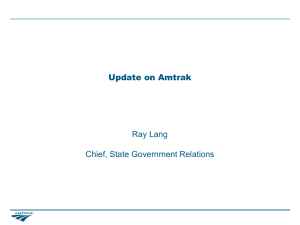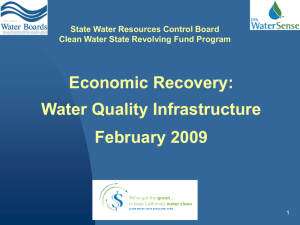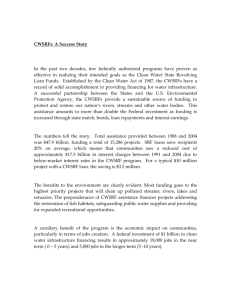(CDBG). As promised, the President unveiled his proposal to merge
advertisement

February 15, 2005 RE: FY 2006 Federal Budget Proposal Supplemental Analysis Dear Mayor: The Federal counterpart of the New Jersey League of Municipalities is the National League of Cities (NLC). We have received an analysis of President Bush’s FY ’06 Budget proposal from NLC. This letter, which relies on that NLC information, supplements our earlier analysis (dated February 10). On Monday, February 7th, President Bush unveiled his $2.57 trillion fiscal year 2006 budget. The budget proposes significant cuts in discretionary domestic spending with the goal of reducing the deficit in half by 2009. The proposed budget would place mandatory spending caps on domestic discretionary spending, freezing programs through 2010. Homeland Security and defense programs are exempt from the mandatory spending caps. The budget proposes more than 150 reductions and eliminations in non-defense discretionary programs. Among these are many important municipal priorities, including Community Development Block Grants, the long-time funding source for urban renewal, housing assistance, first responder funding, Amtrak, and the Clean Water State Revolving Fund (CWSRF). On Capitol Hill, Democrats and Republicans alike have vowed to fight for the restoration of many of the discretionary programs cut or eliminated from the budget. Many of the funding cuts are already being called “dead on arrival.” Others will have Congressional champions along with interest groups to lobby against their elimination. A long and arduous appropriations season is expected for the first session of the 109th Congress. Specific municipal priority programs are highlighted below. Transportation. The Bush Administration used its fiscal year 2006 budget proposal to signal its willingness to accept a higher overall funding level for transportation reauthorization. The Administration’s $284 billion figure to fund surface transportation through fiscal year 2009 is a $28 billion increase from its proposed $256 billion reauthorization package last year. The Administration’s $57.5 billion FY 2006 transportation budget proposal, one percent less than last year’s proposed budget, represents funding continuity for municipalities. For Amtrak, however, the Administration’s budget proposes to end its federal operating subsidies. (over) 1 Amtrak. The FY 2006 budget proposal provides only $360 million in capital funds for Amtrak’s commuter services along the Northeast Corridor and elsewhere. This represents a 70 percent cut to Amtrak’s current FY 2005 federal support of $1.2 billion. The Administration, clearly frustrated that its Amtrak reform proposal is stalled, argues that “with no subsidies, Amtrak would quickly enter bankruptcy, which would likely lead to the elimination of inefficient operations and the reorganization of the railroad through bankruptcy procedures.” The Administration maintains its offer to support more money for Amtrak if Congress enacts the Administration’s Amtrak management and financial reform legislation. According to the Administration, reform would put Amtrak on track to financial stability and provide states and localities with flexibility to integrate intercity passenger rail locally. The Administration’s FY 2006 budget would also eliminate funding for high speed rail. Community Development Block Grants (CDBG). As promised, the President unveiled his proposal to merge CDBG along with 17 other direct grant programs into a new $3.71 billion Strengthening America's Communities Initiative (SACI) to be administered by the Department of Commerce. For the previous budget year, funding for all 18 programs totaled roughly $5.3 billion. CDBG, by itself totaled just over $4.7 billion in 2004. The President argues that the new proposal would "strengthen America's transitioning and most needy communities, while making use of taxpayer dollars by reforming and restructuring many of the existing Federal economic and community development programs." SACI would, according to the Commerce Department, "simplify access to the Federal system, set new eligibility criteria, and establish strong accountability standards all in exchange for the flexible use of the funds so the communities most in need will be assisted." The program will "better target assistance and achieve greater results for low-income persons and economically-distressed areas." HOPE VI. Once again, the President's FY 2006 budget proposal recommends eliminating funding for the HOPE VI program. It also proposes to rescind the entire $143 million appropriated in the FY 2005 Omnibus Appropriations Act, which would essentially make those funds unusable for this year. HOME. In FY 2005, the HOME program received roughly $1.9 billion with nearly $49 million going to the President’s American Dream Down Payment Initiative (ADDI). The President's budget request adds an additional $41 million to the program. However, the request also carves out $200 million for ADDI. Opportunity Zones. The President’s proposed budget creates 40 opportunity zones (28 urban and 12 rural) selected through a competitive process and decided by the Secretary of Commerce. The tax incentives for the zones would be in effect from January 1, 2006 to December 31, 2015 at a cost of $9.594 billion over that time period. A local government desiring this incentive would first be designated as a Community in Transition if it has experienced the following during 1993-2003: Loss of at least 3% of manufacturing establishments; Loss of at least 3% of its retail establishments; and Loss of at least 20% of its manufacturing jobs. Communities previously benefiting from Empowerment Zones, Enterprise Communities, and Renewal Communities programs would be eligible to apply for opportunity zone status but must relinquish their current status and benefit if selected. Opportunity zone status offers the following tax incentives: Exclusion of 25% of taxable income for business with average gross receipts of $5 million or less; Ability to expense qualified zone property, up to an additional $100,000 above the amount generally available under section 179; Commercial revitalization deduction; and Wage credit for businesses that employ opportunity zone residents within the zone. 2 Homeland Security The President’s proposed budget for funding of first responders programs under the Department of Homeland Security is almost identical to the dollars appropriated by Congress for fiscal year 2005. The Administration has proposed $1.02 billion each for the State Homeland Security Grant Program (SHSGP) and Urban Area Security Initiative Program (UASI). If approved, each state would receive a minimum of $2.6 million in state homeland security grants based on “risk, and an application-based review of need, and consistency with national priorities.” In addition, twenty percent, approximately $200 million must be extracted from both the SHSGP and UASI program to fund law enforcement terrorism prevention activities, effectively eliminating direct funding for the Law Enforcement Terrorism Prevention Grant. Further complicating matters, the Administration proposes that local government use their state homeland security funds for services such as the Urban Search and Rescue and the Metropolitan Medical Response System (MMRS) – programs for which funding was eliminated. The President’s budget request preserves the Congressional directive that 80% of State Homeland Security Grants must go directly to local governments. Title I, No Child Left Behind (NCLB). The President’s budget would increase funding for Title I of the No Child Left Behind Act (NCLB), which provides grants to low-income school districts, by $603 million to $13.3 billion. This is still $9.4 billion below the amount authorized by law. Individuals With Disabilities Act (IDEA). The President proposes a $500 million increase for the IDEA. This would bring the federal commitment to $11.1 billion for FY 2006. This proposed increase would fall short of the funding needed to meet the commitment in the recent IDEA reauthorization to fund 40% of local special education costs within eight years. Energy Environment and Natural Resources With the exception of funding for municipal wastewater, programs of interest to cities and towns would receive modest increases under the President’s proposed fiscal year 2006 budget request for the Environmental Protection Agency (EPA). Wastewater. Of the 150 programs the administration is proposing to eliminate or significantly reduce, four are within the purview of the U.S. Environmental Protection Agency. Reductions are proposed in the Clean Water State Revolving Fund (CWSRF) (proposed reduction of $274 million to $730 million) and funding for Alaska Native Village wastewater needs (reduced from $40 to $15 million because of poor performance and poor results). The proposed budget would also eliminate earmarks for special projects ($500 million) and funding for Water Quality Cooperative Agreements and wastewater operator training programs ($22 million). Reductions in funding for the CWSRF have consistently been proposed for over 8 years by both the Clinton and Bush Administrations. As budget documents again indicate, “[m]ore than $22 billion has already been provided to capitalize the CWSRF, well over twice the original Clean Water Act authorized level of $8.4 billion.” Over $52 billion, which includes state match and repayments to the fund, has been made available since the 1987 Clean Water Act Amendments, of which “more than $48 billion has been provided to communities as financial assistance.” (over) 3 Drinking Water. The President proposes to restore funding for the Drinking Water State Revolving Fund (DWSRF) to its fiscal year level of $850 million. While Congress appropriated $850 million for the program in FY 2005, the omnibus appropriations measure subjected all programs to an across the board .08 percent reduction, which reduced funding for the drinking water loan program to $782 million for the current fiscal year. Since the program was enacted in 1996 (and funding begun in 1997), the DWSRF has made $7.9 billion available primarily to small drinking water systems not in compliance with Safe Drinking Water Act standards. The administration is again requesting that Congress continue state authority, first approved in the 1996 Safe Drinking Water Act Amendments, to transfer up to 35 percent of DWSRF funds to the CWSRF and vice versa. Superfund. The Administration’s budget proposes to increase funding for the nation’s hazardous waste site clean up program to $1.3 billion, $32 million above the current funding level. The budget proposal indicates that the increase is necessary to address the size and complexity of cleaning up the remaining sites on the National Priorities List (NPL). According to the budget, EPA estimates that remedial action at the approximately 80 plus large sites remaining on the NPL can cost $132 million per site. Brownfields. The President is seeking an increase of $46 million over current funding levels for Brownfields remediation for a total of $210 million for fiscal year 2006. Brownfields are old abandoned industrial sites with modest contamination requiring cleanup before being available for productive reuse. Funding is available for site assessment, cleanup and job training activities. The proposed amount would fund remediation at about 6,000 sites. Public Safety. The President's budget proposal reduces or eliminates several programs that the Administration claims "do not have a record of demonstration results." For example, the Administration argues that programs such as the Community Oriented Policing Services (COPS) Hiring Grants, COPS Law Enforcement Technology Grants, Byrne Justice Assistance Grants (JAG), and Byrne Discretionary Grants have not had a demonstrably effective impact on reducing crime. The Administration proposes eliminating these programs, which it claims will save $940 million a year. The President’s budget allocated $118 million for the COPS account, but proposes to cancel $95.5 million of un-obligated balances available under the COPS account -- leaving only $22 million in new budget authority. It is unclear whether multi-year grants that are currently in their second or third year would be cancelled under the budget proposal. Very truly yours, William G. Dressel, Jr. Executive Director WGD/sc 4






